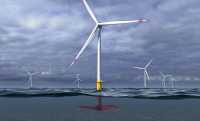
 
     |
| 'Big Wind' Vineyard Wind offshore wind energy project close to approval. 800 MW 'BFD' (Page 4/5) |

|
Notorio
|
MAY 12, 11:16 PM
|
|
|
I guess a benefit of having the wind farm (vineyard???) in the ocean is that all the birds that are slaughtered will conveniently disappear. The last wind pylons I saw shipping up from San Diego to points North were all Made in China. Hopefully Uncle Joe will make sure this new project will be Made in the USA.
|
|

|
rinselberg
|
MAY 13, 01:34 AM
|
|
| quote | Originally posted by Notorio:
I guess a benefit of having the wind farm (vineyard???) in the ocean is that all the birds that are slaughtered will conveniently disappear. The last wind pylons I saw shipping up from San Diego to points North were all Made in China. Hopefully Uncle Joe will make sure this new project will be Made in the USA. |
|
"Birds"
Quoting from Volume II of the Vineyard Wind 1 Offshore Wind Energy Project Final Environmental Impact Statement
| quote | Some turbine strikes could occur as a result of the Proposed Action, though the extent to which this mortality would affect resident and migrant populations of birds is unclear at this time. Given the low expected use of the [Wind Development Area], these impacts would be negligible to minor.
Those species with higher displacement sensitivity would be expected to avoid the Proposed Action, resulting in non-measurable negligible impacts. Conversely, the presence of structures may result in minor beneficial impacts due to the anticipated reef effect. Ongoing and future non-offshore wind activities would not have any impact on birds.
WTGs [Wind Turbine Generators] associated with future offshore wind (excluding the Proposed Action) would be expected to result in a greater number of strikes due to the much larger number of WTGs. Similarly, under the expanded planned action scenario, a much larger area of habitat would be unavailable to foraging individuals of species with higher displacement sensitivity.
In context of reasonably foreseeable environmental trends, combined impacts from this sub-IPF [sub-Impact Producing Factor] on birds from ongoing and planned actions, including Alternative A, are expected to range from negligible to moderate as most of the assumed WTG strikes would be attributed to future offshore wind development (excluding the Proposed Action) and may also result in long-term moderate beneficial impacts due to the large number of structures. |
|
I'm still waiting for the consecutive translation.[This message has been edited by rinselberg (edited 05-13-2021).]
|
|

|
rinselberg
|
MAY 29, 10:50 AM
|
|
"Biden administration unveils offshore wind energy plan for California"
Anna M. Phillips, Rosanna Xia and Sammy Roth for the Los Angeles Times; May 25, 2021.
https://www.latimes.com/pol...or-californias-coast
Article highlights
| quote | The federal government plans to open more than 250,000 acres off the California coast to wind development, the Biden administration announced Tuesday, as part of a major effort to ramp up the nation’s renewable energy and cut its climate-warming emissions.
Under the plan, the administration would allow wind power projects to be built in federal waters off the coast of Central California northwest of Morro Bay, as well as at a second location west of Humboldt Bay. Officials estimate that the two areas combined could generate 4,600 megawatts of electricity — enough to power 1.6 million homes. . . .
California Governor Gavin Newsom praised the plans, noting that California had spent years trying to advance offshore wind power under the Trump administration, with no success. The state, he said, will accelerate its own environmental review process in order to speed up the projects, which he estimated would be built at least 20 miles offshore with enough space for roughly 380 wind turbines. . . .
Although there has been no shortage of interest from wind farm developers in sites along California’s coast — particularly off the Central Coast and Humboldt Bay — efforts have been stymied by regulatory obstacles, engineering challenges created by the Pacific Ocean floor’s steep drop-off, and concerns about the impact the infrastructure could have on migratory birds, marine life and fisheries. . . .
A report released by several California state agencies in March concluded that the cheapest path to 100% clean energy would involve building 10,000 megawatts of offshore wind. . . . |
|
"Sensor-driven turbine platforms could unlock 4,000 TWh of offshore wind"
| quote | | Bringing the biggest turbines to deep waters is an engineering challenge. |
|
Tim de Chant for Ars Technica; May 25, 2021.
https://arstechnica.com/sci...wh-of-offshore-wind/
Article highlights
| quote | Wind turbines already actively manage the pitch of their blades and the torque of their generator to optimize energy production while minimizing fatigue. The new tension leg platform that Blom and his colleagues designed coordinates the turbine’s responses with the tensioning or loosening of each tendon. All of this happens several times a second to continuously adjust the entire system.
The active design could trim up to 35 percent of the total mass of the platform, GE says, allowing wind developers to cut a significant driver of costs. It could also mean that a future platform may help install itself. Today, tension leg platforms require a special ship to bring the platform down to the correct depth. An active system could winch itself down, further reducing costs. How much money could be saved remains to be seen—the team has yet to do a full analysis of how the system would change the levelized cost of electricity, a key metric used to compare different sources of power, though it’s in the team's plans. Currently, ARPA-E is looking to the next two-year phase of the project, which would result in a prototype that could be tested out at sea. |
|
 | | CLICK FOR FULL SIZE |
 | | CLICK FOR FULL SIZE |
|
|

|
rinselberg
|
NOV 20, 10:08 PM
|
|
|

|
maryjane
|
NOV 20, 11:22 PM
|
|
|

|
maryjane
|
NOV 21, 10:36 PM
|
|
|

|
rinselberg
|
NOV 22, 02:42 AM
|
|
"[The Biden administration] is breaking a promise to block [oil and gas] drilling on public lands"
Adam Federman; in the Washington Post; November 19, 2021.
https://www.washingtonpost....a96e00fa3_story.html
| quote | | [From January 20 to October 31 of this year] the Bureau of Land Management approved [slightly more than 3000] new onshore [oil and gas] drilling permits . . . |
|
 [This message has been edited by rinselberg (edited 11-22-2021).]
|
|

|
rinselberg
|
DEC 30, 04:49 PM
|
|
1 minute 54 seconds; narrated with captions, only sounds are music.
It's a newly announced Floating Offshore Wind Energy project in the Canary Islands. Newly announced, as of September, 2022,
This is a top tier commercial promo that artfully eschews the spoken word to viscerally immerse the viewer in the offshore wind energy experience—"major league" accessibility and engagement.
A very brief description of the project:
"Naturgy and Equinor unveil floating wind project off Canary Islands"
Ocean Energy Resources International; September 21, 2022.
https://ocean-energyresourc...-off-canary-islands/
|
|

|
IMSA GT
|
DEC 30, 05:03 PM
|
|
|
Unfortunately the coastal regions will be the only ones who benefit from this. If you tried to do this inland in the central valley where we sit at over 100 degrees for most of the year, these would fail within the first 10 minutes of use from overcurrent draw due to the air conditioners that run 24/7.
|
|

|
rinselberg
|
DEC 31, 06:05 PM
|
|
| quote | Originally posted by IMSA GT:
Unfortunately the coastal regions will be the only ones who benefit from this. If you tried to do this inland in the central valley where we sit at over 100 degrees for most of the year, these would fail within the first 10 minutes of use from overcurrent draw due to the air conditioners that run 24/7. |
|
I think that even during the highest summertime temperatures in the Central Valley, there would be usable wind energy in these offshore areas that are being scoped out, near Humboldt in the north and Morro Bay, farther south.
One big requirement is grid connectivity. That will require a larger investment to "grid up" offshore wind energy from the Humboldt area, than the other area farther south near Morro Bay.
| quote | California also has world-class offshore wind conditions. The areas of Morro and Humboldt Bay both produce wind speeds of over 10 meters per second—more than enough to support commercially viable, reliable floating wind power production.
The reliability aspect of floating wind is not lost to policy makers in a state that experienced rolling blackouts last summer, and where regulators are warning of potential blackouts again this summer if extreme heat conditions take hold. Floating wind complements energy production from solar and other sources, with somewhat of an energy baseload characteristic. |
|
As far as this "energy baseload characteristic"... what this means is that the floating wind farms engineering will tap into the winds farther offshore, which are reliable from early in the day to late at night, with a midday falloff that coincides with the peak energy period for solar. So there's this complementarity between offshore wind and solar.
My plan  is to grow the offshore wind and solar energy portfolios for California, with the expectation that natural gas, nuclear (Diablo Canyon), "hydro" and geothermal (all current energy sources for the California grid) will continue to have their place for the foreseeable future. is to grow the offshore wind and solar energy portfolios for California, with the expectation that natural gas, nuclear (Diablo Canyon), "hydro" and geothermal (all current energy sources for the California grid) will continue to have their place for the foreseeable future.
"The forces propelling California toward global floating wind leadership are strong"
https://www.rechargenews.co...e-strong/2-1-1049518
"California Adopts Offshore Wind Target and Calls for ‘Significant’ Grid Investments"
https://dredgewire.com/cali...nt-grid-investments/[This message has been edited by rinselberg (edited 12-31-2022).]
|
|
    
  |
|















